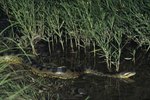
Snakes are infamous for their ability to swallow large items, and tales of pythons and anacondas consuming unthinkably large prey abound. While the subject is rife with exaggeration and myth, most species possess anatomical adaptations uniquely suited for handling large prey. Though most prey represent a third or less of the snake’s body weight, in rare cases, snakes successfully ingest prey more massive than themselves.
Anatomical Attributes
Snakes have flexible skulls that permit them to swallow large, bulky prey. Contrary to popular perception, snakes do not dislocate their jaws to eat large prey, they just have more complex jaw joints than typical vertebrates do. Rather than a simple hinge formed at the junction of the skull and lower jaw, snakes feature another set of bones in the jaw joint. Termed quadrate bones, these bones allow the jaw to hinge at two points, instead of one. Additionally, the lower jaw of snakes is split at the chin; instead of moving as one piece, ligaments allow the two halves of the lower jaw to move independently. In addition to these adaptations, snakes’ skin and digestive tracts stretch to accommodate large prey.
Mass Ratio
Scientists use the term “mass ratio” to discuss the relationship between the size of a snake and the size of its prey. For example, a typical garter snake (Thamnophis sirtalis ssp.) weighs about 5 ounces, and may consume frogs weighing about 1 ounce, which represents a mass ratio of 0.2. Some species consume food with a ratio of 1 or more -- meaning that the prey was larger than the predator. One of the largest mass ratios ever recorded -- approximately 1.6 -- came courtesy of a common lancehead viper (Bothrops atrox) that consumed a lizard. At the other end of the spectrum, many snakes consume prey with very small mass ratios, for example a large rat snake (Pantherophis ssp.) may eat a nestling bird, which represents less than 1 percent of the snake’s mass.
Small-Mouthed Snakes
Though the evolution of an extremely wide gape has been instrumental to the survival of most living snakes, not all snakes are capable of consuming large animals. Some very primitive snakes -- including several blind snake species of the families Leptotyphlopidae and Typhlopidae -- consume termites and other small invertebrates. Instead of evolving to consume large animals infrequently, these snakes have evolved to quickly consume a plethora of tiny prey. Additionally affecting the evolution of blind snakes is their propensity for burrowing in soft substrates -- the need for reinforced skulls that can penetrate the soil is at odds with the highly flexible, loosely articulated skulls of species with large gapes.
Humans on the Menu
While tales of snakes consuming humans abound, verifiable accounts are rare. Regardless, humans and large constrictors have both hunted and been hunted by each other. Herpetologist Jesus Rivas studies green anacondas (Eunectes murinus) in the wild, and has documented two occasions in which large anacondas have made predatory strikes at humans. A 2011 study by Thomas N. Headland and Harry W. Greene, published in “Proceedings of the National Academy of Sciences,” detailed a primitive tribe of the Philippines in which one-quarter of the males had been attacked by reticulated pythons (Python reticulatus) at some point. As some large snakes weigh more than 300 pounds, it is not the mass of humans which makes them hard to swallow, but their relatively wide shoulders.
References
- Snakes: The Evolution of Mystery in Nature; Harry W. Greene
- Live Science: How Do Snakes Swallow Large Animals?
- Biology of the Vipers: Ecological and Phylogenetic Correlates of Feeding Habits in Neotropical Pitvipers of the Genus Bothrops
- Animal Diversity Web: Thamnophis Sirtalis
- United States Environmental Protection Agency: Northern Leopard Frog
- Proceedings of the National Academy of Sciences: Hunter–Gatherers and other Primates as Prey, Predators, and Competitors of Snakes
- Anacondas.org: Predatory Attacks of Green Anacondas (Eunectes Murinus) on Adult Human Beings
- Digimorph: Leptotyphlops Dulcis, Texas Blind Snake
Photo Credits
-
Creatas/Creatas/Getty Images




